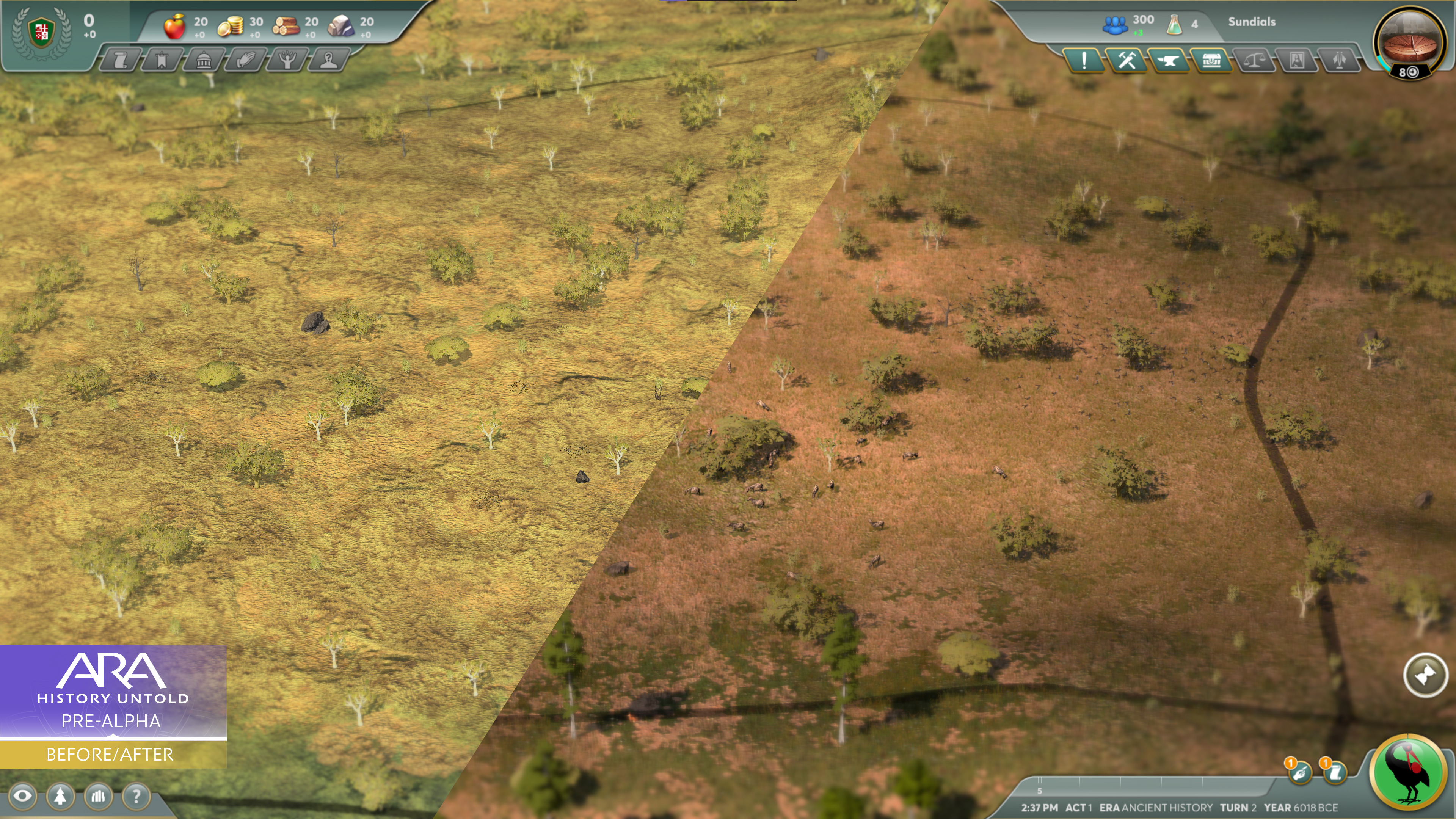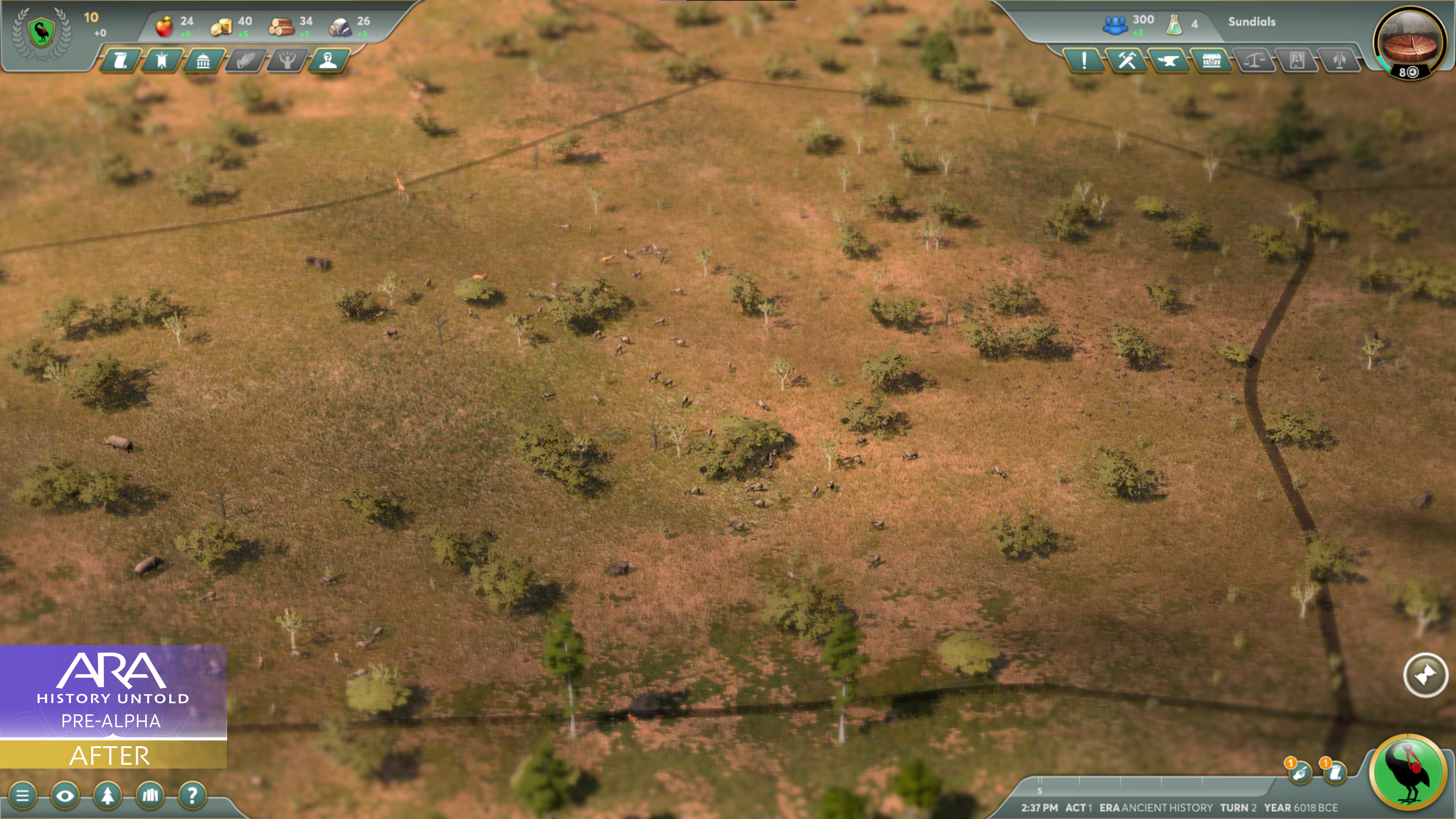Ara: History Untold's Living World - Dangerous Wildlife
One of the key principles we’ve had for Ara since the beginning is that the various components of the game’s Living World are not just visual flourish but are in fact meaningful to gameplay. This takes many forms, including providing players with feedback, reflecting the outcomes of their choices, and calling their attention to important changes or new information in the world.
 A screenshot of an early settlement in Ara: History Untold.
A screenshot of an early settlement in Ara: History Untold.
One of the earliest examples of this in the game is Dangerous Wildlife. Dangerous Wildlife is comprised of various biome-specific animals that were a danger to humans in early agrarian societies. As a game concept, it’s there to help reinforce to the player the areas of the world that are wilder and will require additional resources to settle and provide some additional interesting early game activity and rewards for exploration.
Prior to our Technical Alphas, Dangerous Wildlife was being treated as a set of solo military units, roaming around the map, to be defeated by a player’s early units (e.g., Scouts). They were grouped under a “Wilderness” faction so they would play nice with the other military systems – but what this did in practice was emphasize a focus on early game warfare and create a distracting / frustrating set of obstacles for players to explore and progress.
We received a lot of valuable feedback on how this made players feel – and we made some adjustments.
 A screenshot of the Ara: History Untold Insider Forums, where one user writes: "I hate cougars I hate cougars I hate cougars"
A screenshot of the Ara: History Untold Insider Forums, where one user writes: "I hate cougars I hate cougars I hate cougars"
Today, Dangerous Wildlife is treated instead as a modifier for Sub-regions. Sub-regions that contain Dangerous Wildlife must be “cleared out” before their resources are available for players to harvest and exploit, and doing so gives players a small relevant reward (e.g., Furs for clearing an area of Wolves).
 A screenshot of Ara: History Untold UI showing that wolves will bolck the use of the area until they are defeated.
A screenshot of Ara: History Untold UI showing that wolves will bolck the use of the area until they are defeated.
Now players have a more interesting strategic decision to make early on – should their exploration focus on exploring new areas to find new resources or opportunities for Diplomacy, collecting resource caches on the map (which we’ll talk about in a future post), or clearing wildlife to free up additional regions for settling.
We’re excited to get this feature into players’ hands to see how they like this new approach to fauna in our game. If you’d like the chance to try out this feature before the game’s official release, please head to AraHistoryUntold.com to sign up for our Insider Program for the opportunity to participate in future Alphas.
To be notified when posts like this go up in the future, please click here to Wishlist and Follow the game so you’ll always stay informed on the latest news about Ara: History Untold.

- The Ara: History Untold Team
 A screenshot of an early settlement in Ara: History Untold.
A screenshot of an early settlement in Ara: History Untold.One of the earliest examples of this in the game is Dangerous Wildlife. Dangerous Wildlife is comprised of various biome-specific animals that were a danger to humans in early agrarian societies. As a game concept, it’s there to help reinforce to the player the areas of the world that are wilder and will require additional resources to settle and provide some additional interesting early game activity and rewards for exploration.
Prior to our Technical Alphas, Dangerous Wildlife was being treated as a set of solo military units, roaming around the map, to be defeated by a player’s early units (e.g., Scouts). They were grouped under a “Wilderness” faction so they would play nice with the other military systems – but what this did in practice was emphasize a focus on early game warfare and create a distracting / frustrating set of obstacles for players to explore and progress.
We received a lot of valuable feedback on how this made players feel – and we made some adjustments.
 A screenshot of the Ara: History Untold Insider Forums, where one user writes: "I hate cougars I hate cougars I hate cougars"
A screenshot of the Ara: History Untold Insider Forums, where one user writes: "I hate cougars I hate cougars I hate cougars"Today, Dangerous Wildlife is treated instead as a modifier for Sub-regions. Sub-regions that contain Dangerous Wildlife must be “cleared out” before their resources are available for players to harvest and exploit, and doing so gives players a small relevant reward (e.g., Furs for clearing an area of Wolves).
 A screenshot of Ara: History Untold UI showing that wolves will bolck the use of the area until they are defeated.
A screenshot of Ara: History Untold UI showing that wolves will bolck the use of the area until they are defeated.Now players have a more interesting strategic decision to make early on – should their exploration focus on exploring new areas to find new resources or opportunities for Diplomacy, collecting resource caches on the map (which we’ll talk about in a future post), or clearing wildlife to free up additional regions for settling.
We’re excited to get this feature into players’ hands to see how they like this new approach to fauna in our game. If you’d like the chance to try out this feature before the game’s official release, please head to AraHistoryUntold.com to sign up for our Insider Program for the opportunity to participate in future Alphas.
To be notified when posts like this go up in the future, please click here to Wishlist and Follow the game so you’ll always stay informed on the latest news about Ara: History Untold.

- The Ara: History Untold Team











